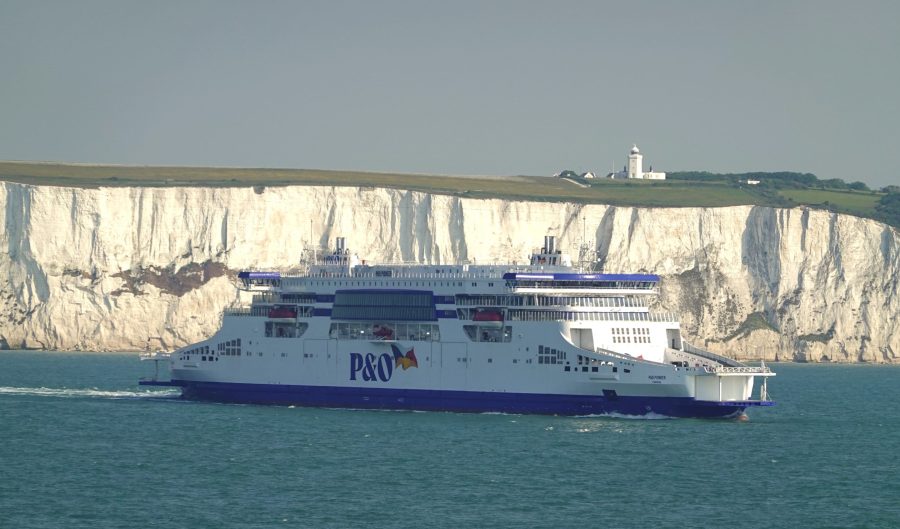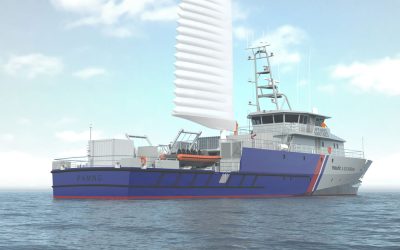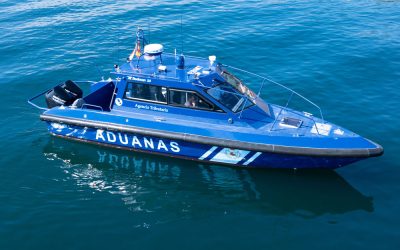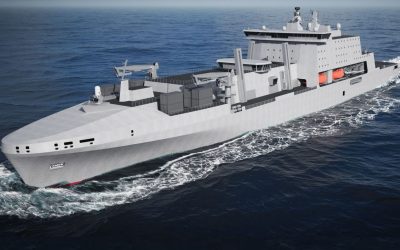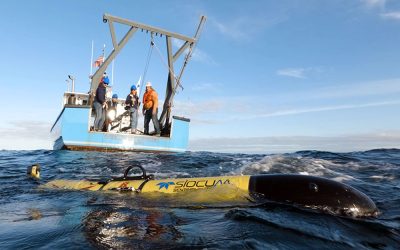By Philippe Holthof, Correspondent
True to its name, the Guangzhou Shipyard International-built P&O Pioneer introduces many firsts on the English Channel. Besides being the first double-ended ferry on the Dover-Calais route, P&O Ferries’ new flagship also pioneers the hybrid element. This, together with the double-ender design and a long list of energy-saving technologies, guarantees a 40% fuel consumption reduction when benchmarked against P&O Ferries’ 2011-12-built Spirit class.
Although a double-ended design had been earlier on the drawing board of Channel House, P&O Ferries’ Dover headquarters, it only surfaced again shortly after the so-called Ship of the Future project kicked off in conjunction with the 2017 edition of Nor-Shipping. When the Spirit class sister ships were ordered in 2008, alternative fuel options for large ro-pax ferries, let alone hybrid technology, were still few and far between. Not surprisingly, this resulted in a conservative approach with a conventional propulsion plant of four main engines driving twin controllable pitch propellers and four auxiliaries generating the electrical power. So, the focus was rather on optimising the hullform and ro-ro intake. Indeed, with their impressive vehicle deck capacities of 2,741 freight lanemetres plus 1,000 car lanemetres on a separate 3.3m-high upper car deck, the Spirit class represented a quantum jump compared with the ships they replaced, the 1987-built Chunnel beaters Pride of Dover and Pride of Calais.
Like the Spirit class, the new Ship of the Future or Fusion class has the ability to hoover up freight and cars at peak times, but this is where any comparison ends as the design of the newbuilds started from a blank canvas. While all design options were open, building an improved, ‘lessons learned’ Mk II version of the Spirits was excluded as the DP World-controlled ferry operator was poised to build a best-in-class Channel ferry with the lowest possible emissions footprint per transported truck and car thanks to the implementation of the latest energy consumption reduction technologies.
As the project gained momentum and with Denmark’s OSK Design selected to take care of the full design package, all the do’s and don’ts as well the pros and cons of a single-ender versus a double-ender design were carefully analysed. On the Dover-Calais route, single-ender ferries typically berth stern-to in Dover and bow-in in Calais, requiring two 180-degree turning manoeuvres in the westbound direction. For the Spirit class, the port manoeuvring time relative to Calais-Dover crossings adds about 15 minutes to the overall berth-to-berth crossing times. To compensate for this lost time, the speed needs to be increased at sea to keep the 90-minute berth-to-berth schedule. Eliminating the 180-degree turning manoeuvres effectively results in a reduction of the top speed requirement from 21.5knots to 17.6knots. With no stone left unturned, the double-ender design proved to be the most sustainable solution. A double-ended platform with the duplication of wheelhouses doesn’t come cheap but the fuel savings generated by eliminating up to 10 x 180-degree turning manoeuvres per day during at least 20 consecutive years outweighs the extra cost to build a double-ended ferry.
The hybrid diesel-electric propulsion system with four ABB Azipods is yet another additional cost that ultimately pays off in the longer term on account of lower maintenance costs. On the Spirit class, maintenance costs have been high as they each boast four main engines, four auxiliary engines, four shaft generators, two gear boxes, three bow thrusters, two steering gears and two rudders. The maintenance spend for the Fusion class is estimated to be 50% lower while the refit costs on a five-year survey cycle are expected to be 30% lower.
The peculiarity of a double-ended ferry is that it has no stern but rather two bows – one at either end. This is because it always berths bow-in, so instead of stern and bow P&O Ferries rather refers to Dover end and Calais end, respectively.
And the winner is…
Although having built ro-pax tonnage in Japan in the early 2000s, P&O Ferries has remained rather loyal to the European shipbuilding cluster. While the Spirit class was completed by STX Finland’s Rauma facility, today’s Rauma Marine Constructions, earlier ro-pax generations were built by German yards that have been long out of business. As for the Ship of the Future project, P&O Ferries’ newbuilding team initially didn’t have Chinese yards on their radar. Instead, they had shortlisted European and South Korean yards that had been bidding for the Spirits.
At 47,653gt, the 230.5m-long and 30.8m-beam P&O Pioneer and soon-to-be-introduced sister ship P&O Liberté are the world’s largest double-ended ro-pax ferries. So, logically, P&O Ferries had long negotiations with Flensburger Schiffbau-Gesellschaft (FSG) and Remontowa Shipbuilding which had both built double-ended ferries for Canada’s BC Ferries. Whilst the three Coastal class double-enders built at FSG were the then world’s largest of their kind, the four Salish class built at Poland’s Remontowa were way smaller which was one of the reasons why negotiations didn’t lead to an order. Damen, which had also built double-enders, was yet another hot contender and was the only European yard to remain in the running until the very end. It would have built the P&O Ferries double-enders at its then newly acquired Mangalia site in Romania, but due to the poor condition of the yard facilities, the Dutch shipbuilding group couldn’t guarantee a 2023 delivery.
It wasn’t until DP World recommended taking China into consideration that negotiations started with Jinling Nanjing and Guangzhou Shipyard International (GSI). Other Chinese yards were also in the mix but a €260 million double order with an option for two more vessels was eventually signed with GSI in September 2019. The option for two more sister ships was not exercised as P&O Ferries awaits the installation of plug-in facilities at both Dover and Calais to enable full electric, zero-emission operations.
SRtP compliant by virtue of its design
When the Spirits were built, Safe Return to Port (SRtP) rules didn’t apply yet as the keels were laid before 1 July 2010. Even so, P&O Ferries voluntarily incorporated the SRtP rules in their design. While the efficacy of the current SRtP rules can be argued, the separation of the engines and ancillary systems is intrinsic to the double-ender design. An emergency bridge is yet another SRtP requirement. Although it is not mandatory for the emergency bridge to have windows, the most essential navigation equipment must be duplicated. As the Fusion class has a Dover-end and Calais-end bridge it automatically complies with the SRtP rules once again.
In addition, OSK Design developed a Safe Return to Sea (SRtS) standard which allows the Fusion class to remain in service even after a minor SRtP incident. Although a voluntary initiative, DNV has meanwhile also added a Safe Return to Sea class notation.
Batteries and Azipods
While the Spirit class’s propulsion pack was something of an evolution compared to P&O Ferries’ ro-pax generation from the early 1990s, the Fusion class’s diesel-battery hybrid system and podded propulsion are nothing short of a revolution. The engine room compartments occupy the best parts of Decks 1 and 2 with a B/5 double-skin spanning almost the full length of the hull. Midships, a ballast water room on Deck 1 and storerooms on Deck 2 separate the Dover-end from the Calais-end engine rooms. When considering the Dover-end as the stern and the Calais-end as the bow, then the hold for the stores trailer is on the portside of the centreline. Already on the Spirits, a stores trailer was no longer stowed on the main deck as it obstructed the traffic flow. On Deck 3 a side-hinged panel opens with the stores trailer lowered via a 15m-long hydraulic lift that connects the main deck with the single trailer hold. The trailer’s unloading platform is flush with the storerooms. Actually, all watertight doors on Deck 2 are flush with the floor, creating obstruction-free passageways.
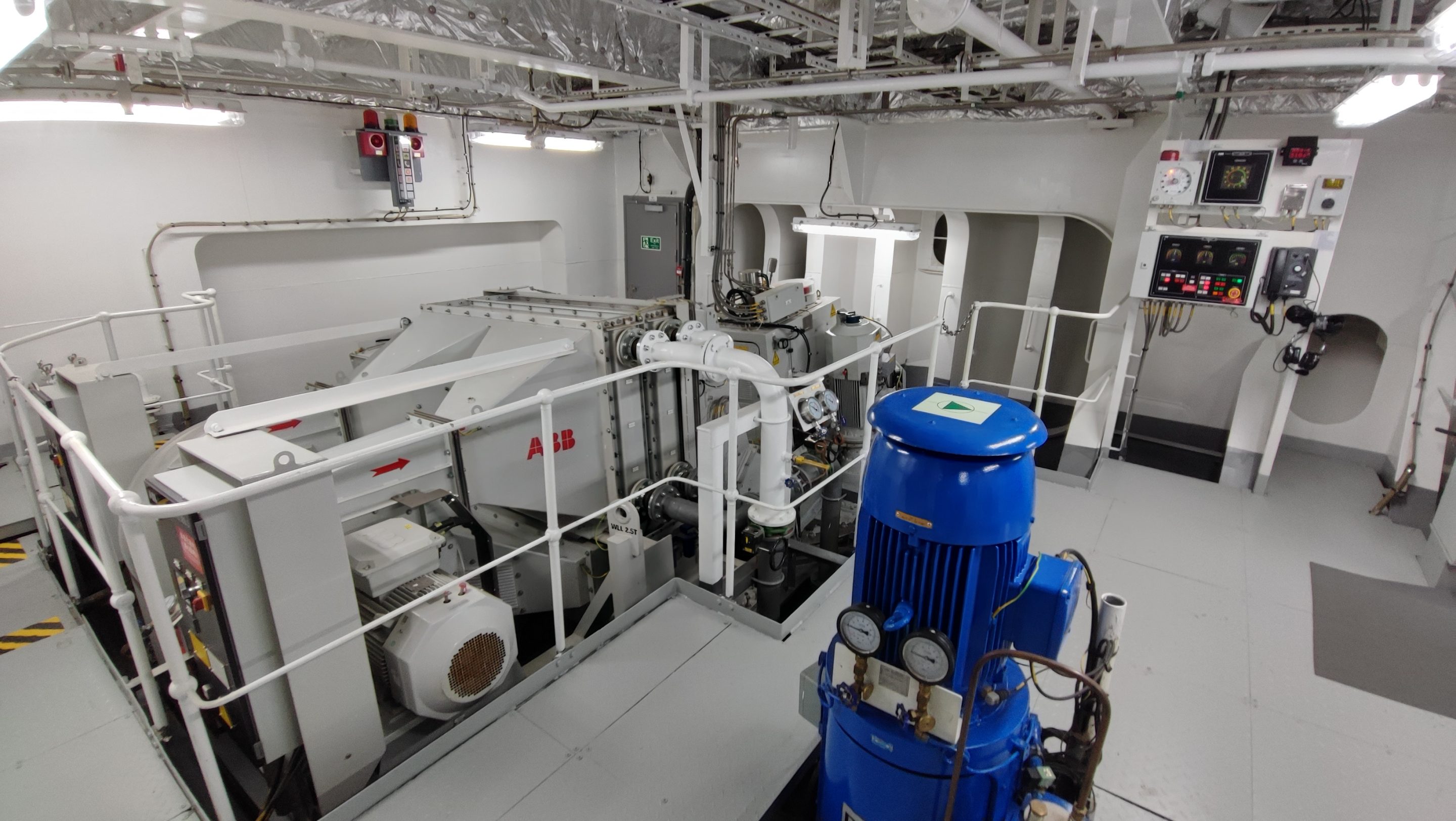
ABB Azipod room forepeak. Source: Philippe Holthof
Abaft the midship section, at the Dover-end, is the engine control room. Its mirror view at the Calais-end boasts a machinery and electrical workshop together with a small storeroom and large auxiliary equipment room. Further forward at either end are the engine compartments. Each compartment holds two very compact, side-by-side stowed Wärtsilä 16V31 four-stroke medium speed engines. The ultra-economic engine type has been recognised by the Guinness Book of World Records as the world’s most efficient four-stroke engine. With an output of 9,760kW at 750rpm and 100% MCR, the gensets have an advanced fuel injection system, combined with air injection technology, enabling the most efficient and economical use of low sulphur content marine diesel oil. ABB’s two-stage Power2 turbocharger technology helps to achieve up to 5% in fuel savings and up to 60% of NOx emissions.
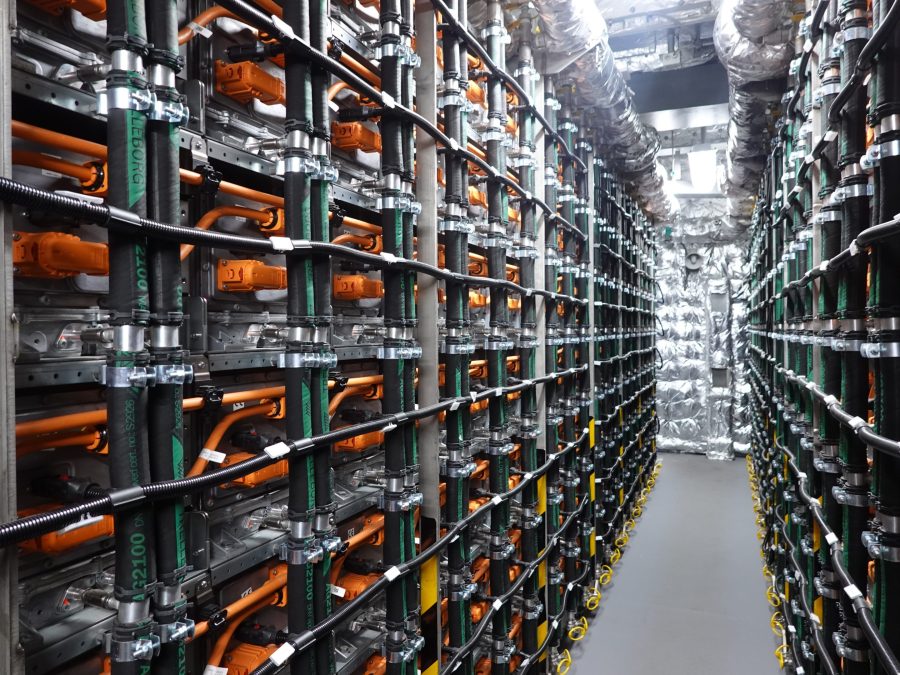
Battery room. Source: Philippe Holthof
The 22NM stretch of water between Dover and Calais warrants a full-electric operation, providing the ports offer high-voltage rapid charging facilities. While the Port of Calais invested in a brand new three-berth outer port, it didn’t provide onshore power supply (OPS) facilities, something critical in the future maritime energy mix. As an OPS system is also lacking in Dover, P&O Pioneer’s 1,160 individual XALT Energy batteries are charged when power demands from the gensets are below 85 to 90%. This is during arrival in port, at berth and when leaving port. Located in four battery rooms (two fore, two aft) outboard of the B/5 double-skin on Deck 2, the lithium-ion NMC-graphite batteries deliver a combined power of 8.816MWh. The 17.6knot design service speed can be achieved utilising two generator sets or one generator and the batteries with a 15-minute autonomy when sailing at a 17.6knot service speed. This means that any one generator can be removed from service for maintenance whilst still adhering to the SRtP rules.
On the Dover-Calais route, sufficient power to manoeuvre is a prerequisite. Ships that have not been purpose-built for the route are typically underpowered. Implementing azimuth thrusters is a radical departure from the combination of controllable pitch propellers, rudders, bow thrusters and even stern thrusters. The four ABB Azipods – two at either end – are of the compact DO1600 type rated at 7.5MW each. Unlike the larger versions typically used on cruise ships, the DO1600 allows for easy maintenance which can be performed while the ship remains in operation. Each thruster is fitted with a five-bladed monobloc propeller of 4.0m diameter.
When on passage, the forward pods are fixed at zero pitch and provide approximately 30% of propulsion power. The aft pods provide 70% propulsion power and are used to steer the vessel, the steering angel being limited to 35 degrees either side of the neutral position. During manoeuvring all four pods can rotate through 360 degrees and thrust in any direction.
With energy efficiency at the heart of the design, the Fusion class also boasts a waste heat recovery system while its power management system uses software to turn off the lighting and ventilation in empty areas, as well as optimising the utilisation of engines, batteries and energy recovered from waste heat.
As befits a double-ender design, many systems are duplicated. This also applies for 704 Academy’s active fin stabilisers with each pair being optimised for use in a single direction, guaranteeing a smooth crossing regardless in which direction the ferries are sailing.
Lessons learned from the Spirit class
On a short route like Dover-Calais, it is critical to find the right balance between lanemetre intake and time at berth as it is pointless to operate a juggernaut if it cannot be turned around in under 60 minutes. With ferries being part of the supply chain, short port turnarounds with fast unloading and loading are key. The 2,741lanemetre cargo capacity of the Spirit class was deemed optimal and a further increase of freight capacity would have come at the expense of port turnaround times. So, instead of further increasing the lanemetre intake, OSK Design and P&O Ferries looked at ways to maximise and further optimise freight vehicle capacity. This has been achieved by increasing the free deck height of the uppermost car deck from 3.3m to 3.6m, allowing for campers and vans to be parked here, freeing up much-needed freight space on Decks 3 and 5.
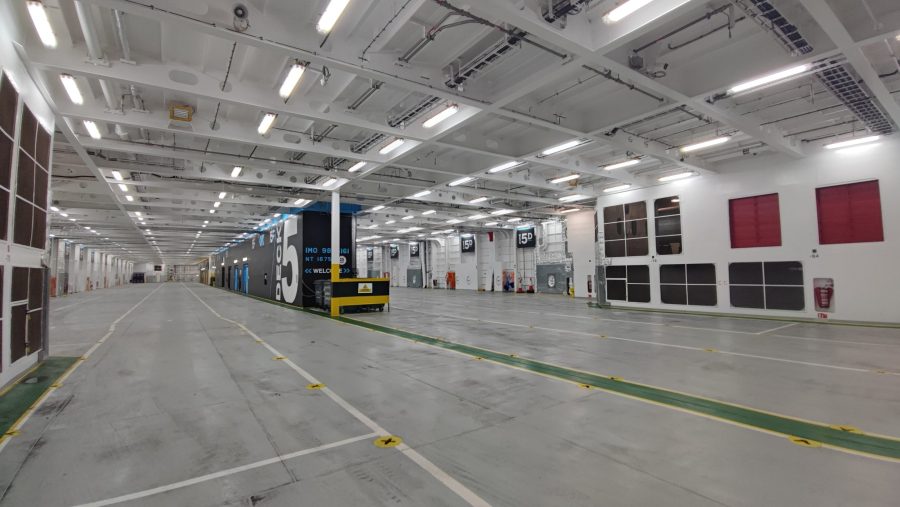
Deck 5. Source: Philippe Holthof
To speed up unloading/loading operations, the open fixed ramps between Deck 5 and Deck 7 are wider and shallower than on the Spirits, being surfaced with Bimagrip anti-slip coating rather than tightly spaced herringbone bars. The width of all four ramps – two forward and two aft – has increased to 4.25m and thanks to the 42m length, the angle has been reduced to 8.3 degrees. Entering Deck 7 is through 4.25m-wide and 3.8m-high hydraulic top-hinged doors made by Wuxi Dongzhou Marine Equipment which also manufactured the 12m-wide and 4.8m-high end doors on Deck 5. On the Spirits the contrast between outdoor and indoor lighting slows down loading operations. This was especially the case on Deck 7 and has been addressed with ample LED lighting on all three vehicle decks. Up to 182 cars equivalent to 1,066 car lanemetres can be stowed on Deck 7 with four 2.4m-wide lanes on either side of the centre casing.
Two flights of stairs separate the uppermost vehicle deck from the lower accommodation deck – Deck 8. Passengers with reduced mobility can use one of the five passenger elevators – this compares to three passenger elevators for the Spirit class. P&O Ferries has gone the extra mile to make it as easy as possible from the moment that passengers get out of their vehicles. To achieve this, the Fusion class ships have been split up into two colour zones: blue (Dover-end) and yellow (Calais-end). On either side of the centre casing, each colour zone has been further divided into two letter zones: A and B for yellow, C and D for blue. Preceded by the deck number, the colour and letter zones are clearly displayed throughout the vehicle decks.
Deck 3 is the 5m-high main vehicle deck. To fit the berths in Dover and Calais, the two ends on which the lower linkspan is dropped are different. The Calais-end bow spades on Decks 3 and 5 are fitted with a hydraulic flap arrangement to fit all three berths in Calais’ new port with the flap down and berths 7, 8 and 9 in the old port with the flap up. Dover-end spades on Decks 3 and 5 are fitted with sliding beam arrangements to fit both portside to berth 8 and starboard side to berths 7 and 9.
The Fusion class is about one truck length longer than the Spirits, something which was necessary to compensate for the loss in lanemetres on account of the double-bow shape. This also means that P&O Pioneer has two sets of bow doors and watertight doors. The side-hinged clamshell doors that give access to Deck 3 fore and aft have been supplied by Switzerland’s SeaNetGroup. Up to 1,314lanemetres can be stowed on the main deck, spread over eight 3.2m-wide lines – four on either side of the casing. Similarly, 1,278lanemetres of freight can be stowed on Deck 5. Up to 12 accompanied trailers with hazardous goods can be stowed on the three lanes fore and aft of the accommodation. On both Deck 3 and 5 the inside lanes next to the centre casing walkways are 3m wide instead of 3.2m.
Light and airy public spaces
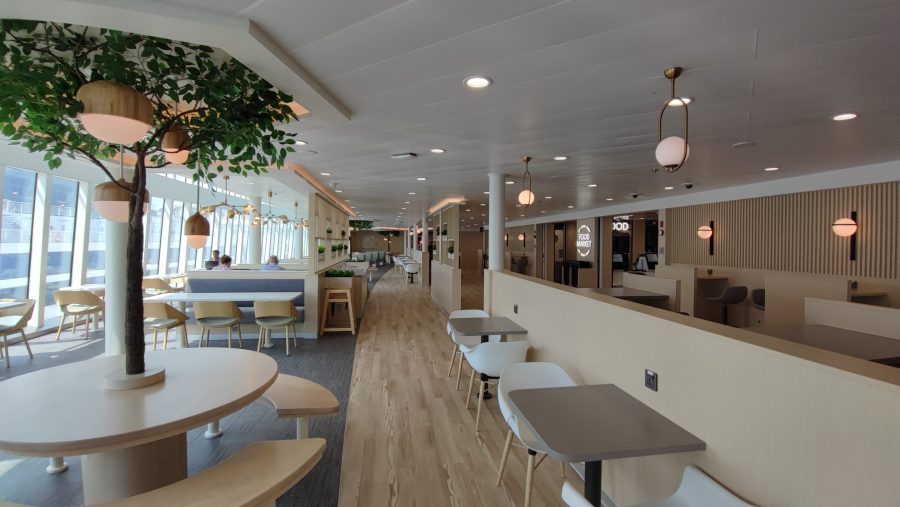
Food Market on Deck 8. Source: Philippe Holthof
Although Finland’s dSign Vertti Kivi & Co provided a draft interior design, P&O Ferries decided to keep the whole design package under one roof, appointing OSK Design’s interior architecture division for the P&O Pioneer’s and P&O Liberté’s interior design. As these ships are here to stay for at least 25 years, OSK Design deliberately chose a timeless yet cosy design that meets contemporary simplicity.
Performing over 3,500 single crossings per year, ferries on the Dover-Calais route are exposed to hard wear and tear so robust and durable materials were chosen. All of the ship’s heavy foot traffic areas have highly durable vinyl flooring rather than carpet. Supplied by both Gerflor and Armstrong Flooring, the vinyl floors with wood and tile effects, but also fashionable carpet look, are hardly distinguishable from real wood-, tile- or carpet-covered floors. The vast sundecks that are wrapped around the fore and aft sections are covered with Herculan Marine EcoTeak’s easy to maintain seamless flooring, an environmentally friendly alternative to genuine teak flooring. These well-protected, glass-screened open decks are a welcome change from earlier cross-Channel ferry generations with ample fixed low-maintenance lightweight seating and furniture.
As port stays are typically very short, all public spaces have been designed with easy and quick cleaning in mind. For instance, all swivel chairs self-move back into position – ceiling-hung toilet partitions don’t require components to be mounted on the floor, allowing for easy floor cleaning. It’s the combination of all these little design details that make a big difference.
The general arrangement of the passenger decks, Deck 8 and 9, follows a symmetrical plan on Deck 8 while Deck 9 is somewhat asymmetrical as it holds the ‘destination venues’, notably the commercial drivers’ facilities, the luxurious Club Lounge, The Pet Lounge, the quiet lounges an
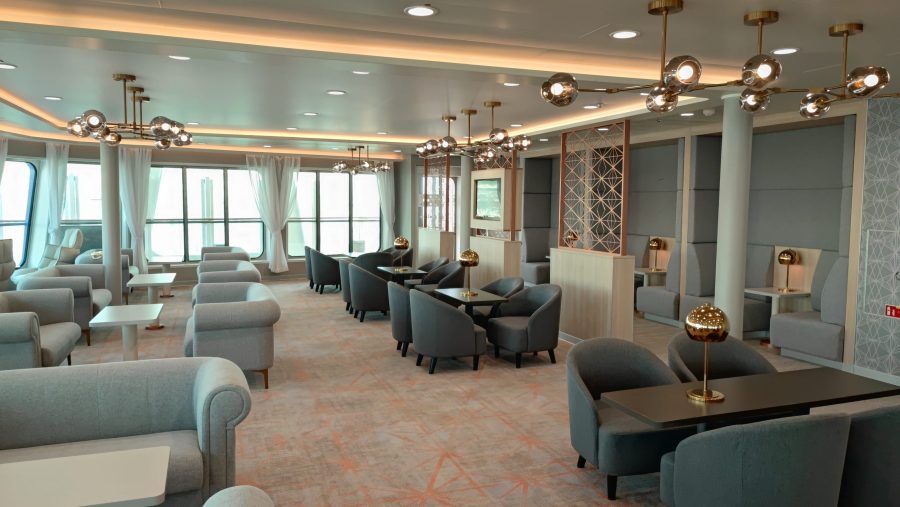
Club Lounge. Source: Philippe Holthof
d The Kitchen, the ship’s secondary restaurant. Two full-width stair lobbies divide each deck into three fire zones. Accessed from the Dover-end stair lobby, the large duty-free shop occupies the entire aft part of Deck 8. Its mirror view forward, accessed from the Calais-end stair lobby, is the 287-seat boutique-style The Lounge Bar.
The restaurant facilities are concentrated in the midship section, characterised by its signature cantilevered glass curtain wall on either side. The ship’s main hub is the 410-seat open plan Food Market, spanning the full width of Deck 8. The starboard side (when Calais-bound) is open 24/7 as it holds the guest services desk with bureau de change and the main children’s playroom – one of three playscapes. Finished in a bright and airy pallet, the design elements incorporate greenery and woodland scenes to create a natural, calm feel. The restaurant’s central self-serve area has been inspired by the fast-flowing food markets found in high footfall service stations, train stations, airports and shopping centres with grab and go options and self-serve tills. There are glass doors at each side of the self-serve area, allowing for one side of the Food Market to be closed off, making it operationally more flexible.
One deck up, on Deck 9, located between the Dover- and Calais-end stair lobbies is The Kitchen on the starboard side and the commercial drivers’ restaurant facilities to port. The Kitchen is a new catering offering, serving fresh hot fast food on an ‘order to collect’ basis in a similar fashion as in major high street fast-food chains. Thanks to the protruding double-height windows, a two-deck atrium is created, connecting the Deck 8 Food Market with The Kitchen and commercial drivers’ restaurant on Deck 9. For acoustic comfort, the Deck 9 ‘balconies’ are screened off by floor-to-ceiling windows. The facilities for the commercial drivers extend forward with a plush lounge accessed from the Calais-end stair lobby. It is a haven of tranquillity with different types of seats, including reclining chairs, chaises longues and even couchettes.
Just aft of the commercial drivers’ restaurant is the quiet lounge section. Separated by the Dover-end stair lobby, one lounge boasts 90 reclining seats and the other one 107, allowing for some flexibility as one of the lounges can be kept closed. Adjacent to the smaller of the two quiet lounges is the Club Lounge. Offering a premium experience in a high-end ambience, the Club Lounge boasts a dining area with food and drinks buffets as well as a relaxation area. The dedicated Club Lounge sundeck is designed to replicate the exclusive feel inside with ‘luxury’ outdoor seating.
The Pet Lounge forward on Deck 9 completes the passenger facilities. The supplement to use The Pet Lounge includes free hot and cold drinks that are available from the self-serve ‘Coffee Corner’. As part of their entrance fee, users of The Pet Lounge park their vehicles in zones 7A and 7B, close to the yellow, Calais-end stairway.
Two navigation bridges
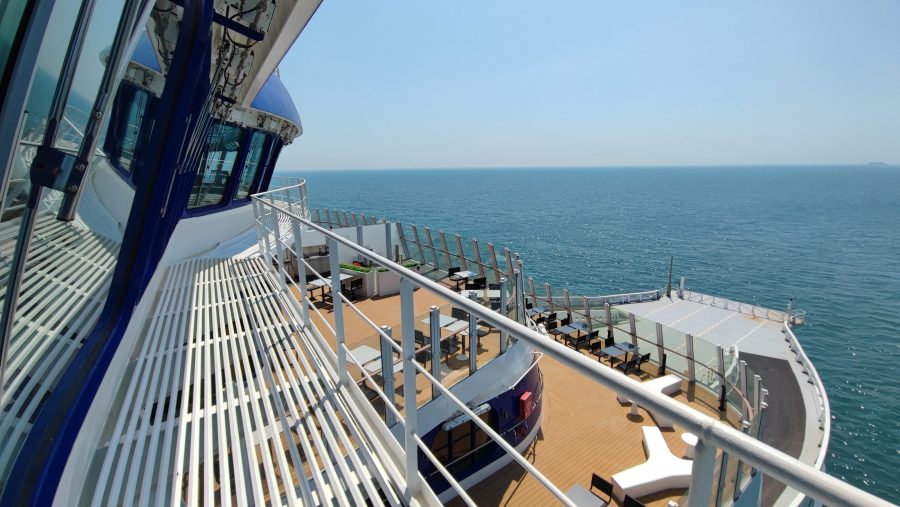
View from the bridge. Source: Philippe Holthof
Having two navigation bridges is by no means a cheap solution. The bridges’ central integrated consoles follow the typical ‘cockpit’ layout with officers seated in ergonomic pedestal-mounted high-back chairs to better grasp the situation around the ship. P&O Ferries chose Kongsberg’s K-Bridge integrated navigation system (INS) which provides a single-user interface to multiple connected systems, enabling deck officers to focus on primary navigation tasks without having to switch their attention between different instruments. Whether it is K-Bridge Radar, K-Bridge ECDIS, K-Bridge Conning which can also be used to view CCTV from different cameras mounted around the vessel, including thermal imaging cameras (to avoid collision with migrant boats), all 18 screens are interchangeable. To offer the best of both worlds, the higher-frequency X-band radar scanner can be combined on a single radar display with the lower-frequency S-band radar scanner, eliminating blind arcs. The seamless overlap of X-band and S-band radars on a single radar display guarantees a 360-degree picture, showing both nearby and far-off targets. The bridge’s central control desks and consoles are height adjustable as is the helm station.
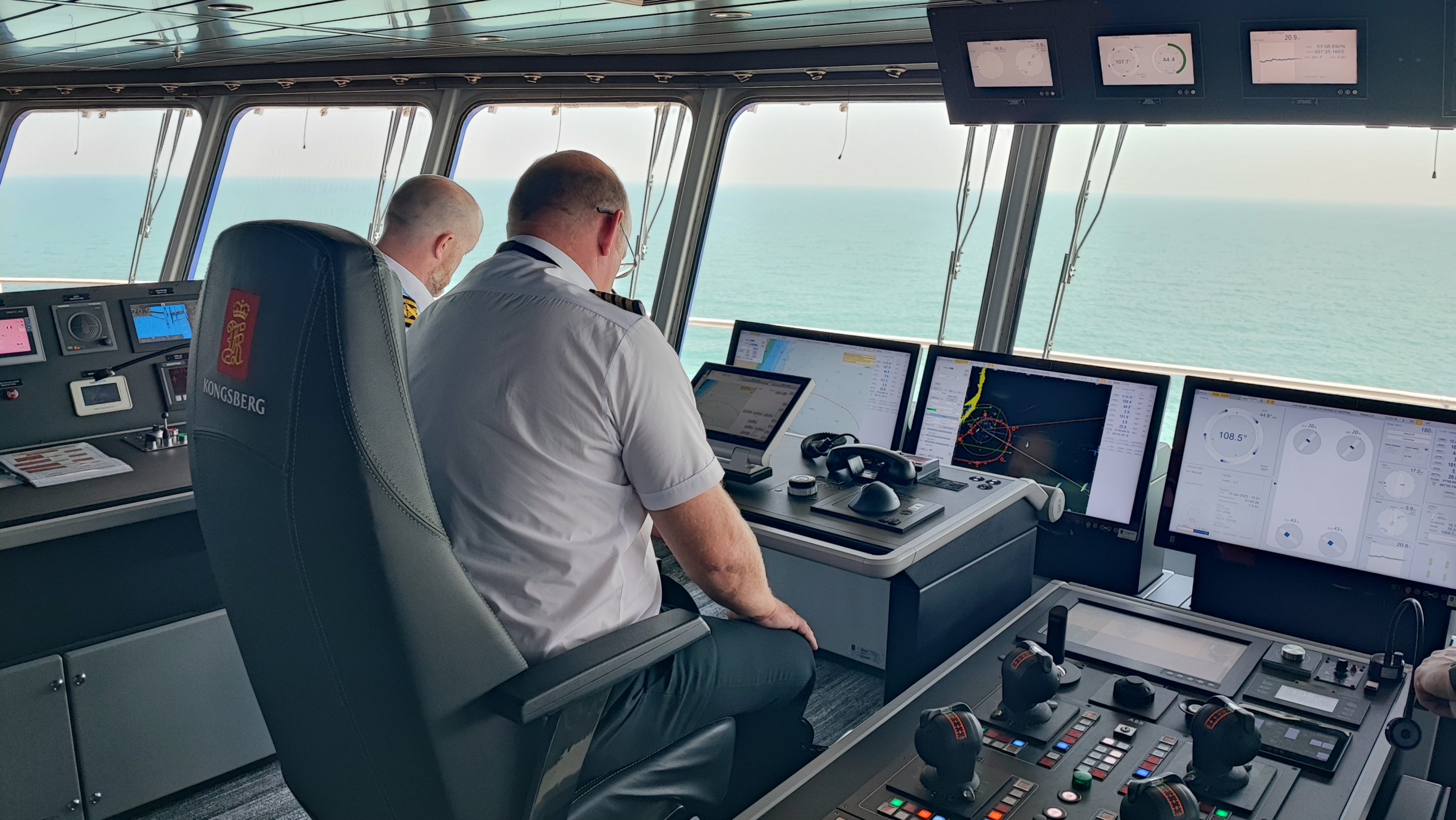
ABB Azipod controls. Source: Philippe Holthof
Manoeuvring the conventional way using shaftlines, rudders, bow and stern thrusters is a far cry from Azipod manoeuvring. Each Azipod unit has its own lever to control the propeller speed and steering angle. The system also comes with a joystick, combining all four levers in a single device. Each bridge has 12 levers – four on the central navigation desk and four on each bridgewing desk.
The introduction of P&O Pioneer also sees the re-introduction of lifeboats instead of an all-MES solution as first adopted by P&O Ferries on the converted Darwin class pair in 2003 and repeated on the Spirit class. One of the reasons to re-install lifeboats is the high maintenance cost of MES chutes, so the P&O Ferries newbuilding team opted for a combination of four 150-person lifeboats and four VEMCs connected to a total of ten inflatable drop rafts.
TECHNICAL PARTICULARS
P&O Pioneer
Length oa: 230.5m (230.8m with Calais-end Deck 3 spade extension)
Length bp: 216.8m
Breadth, moulded: 30.8m
Depth to main deck: 9.8m
Draught, design: 6.23m
Gross tonnage: 47,653
Net tonnage: 16,754
Deadweight: 9988.9t
Lanemetres: 2,592m (+ 1,066 car lm or 182ceu on Deck 7)
Passengers: 1,437
Passenger cabins/berths: N/A
Main engines: 4 x Wärtsilä 16V31
Output: 4 x 9,760kW at 750rpm and 100% MCR
Service speed: 17.6knots
LSAs: 4 x 150-person Viking Norsafe lifeboats + 4 x Viking VEMC – 1,314 persons + 2 x Viking Norsafe Merlin-615 MKI fast rescue boats
Class* : Det Norske Veritas
Class notation: +, 1A, Ferry A, E0, BIS, NAUT (AW, ICS), LCS (DC), Recyclable, COMF (C‐2, V‐2), Clean, Battery (power), HMON (C, O4, O2, W)
Flag: Cyprus
(*) As built class, transferred to Lloyd’s Register
